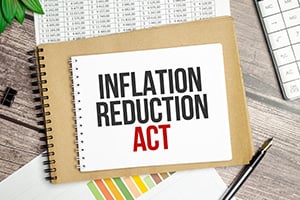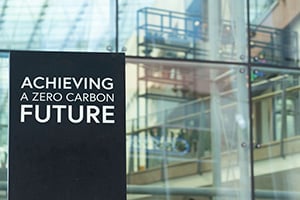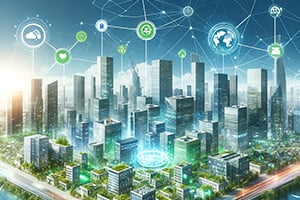
ENERGY STAR is a United States government program initiated in 1992 as a motivating force for businesses and consumers to decrease their consumption of energy. Both products and buildings carrying the ENERGY STAR label meet specific standards established by the Environmental Protection Agency (EPA) and the U.S. Department of Energy (DOE). Residences and buildings designated as ENERGY STAR-certified possess both energy-efficient and sustainable factors and components.
About thirty-five percent of Fortune 500 corporations are in partnership with the program as of 2012 and are committed to its initiatives and goals. These corporate partners include Merck, Ford, PepsiCo, Target, TIAA Cref, Cleveland Clinic, CBRE, 3M, USAA Real Estate Company, Verizon, Toyota USA, NHL, and Providence Health Services.
Atlanta: A Top Five Green City
Both the EPA and DOE use systematic rigorous process, which relies upon pollution, market, and engineering savings analysis data. EPA and DOE also use data collected from industry stakeholders to establish the standards and criteria for ENERGY STAR certification. Sustainable Investment Group (SIG) is headquartered in one of the country’s “most green” cities. According to Atlanta Business Chronicle, Atlanta is currently ranked fifth in the nation’s top thirty green cities (as determined by total percentage of commercial buildings, which meet the Green Building Adoption Index).
Efficiency: Improved Air Quality, Lower Energy Bills
EPA requires that certified buildings are a minimum of fifteen percent more efficient than standards for others. These factors include, but extend beyond, indoor air quality, site sustainability, materials/resources, energy/atmosphere, and water efficiency. The long-term values of these achievements benefit landlords and tenants by achieving lower energy bills and healthier, more breathable air.
Certification Considerations
Certification considers sustainable systems used in residential or commercial properties, including computers and information technology systems, lighting, heating, cooling, appliances, and electronics. Those who purchase program-certified properties help the environment and everyone in the community. Sustainable Investment Group assists clients in identifying and evaluating all systems in use.
Design of lighting systems is especially important. According to “Energy for Sustainability: Technology, Planning, Policy,” matching the lighting design or fixtures to the intended function can dramatically decreases energy use. For instance, ambient (or room-area general light) lighting can be decreased if the lighting design includes task-focused lamps or fixtures. Program-certified fixtures may be used to ensure compliance in this regard.
Other approved devices and appliances include computers-computer peripherals (monitors, scanners, and printers); air conditioners light bulbs; and furnaces, stoves, washers and dryers.
Energy Efficient Mortgages: More Financing
Buyers of program-certified program homes can obtain Energy Efficient Mortgages (EEM). In some cases, an EEM loan helps the prospective buyer for qualify for a larger mortgage loan. Both the Federal Housing Authority and Veterans Administration offer these mortgage loans to prospective buyers and private lenders. State tax incentive programs and federal programs may also be available to help buyers purchase energy-certified residences or buildings.
Sustainable Commercial Buildings: A Strong Growth Trend
According to program statistics, more than twenty thousand commercial buildings in the United States are program-certified. These certified buildings and plants represent three billion square feet of commercial space. These properties save a combined USD 2.7 bn in energy cost savings a year. Importantly, they save more than 14 m in MtC02e (greenhouse gas emissions) per annum, or the equivalent of energy used by two million homes each year.
More than three hundred thousand buildings are known to monitor and measure energy usage. These buildings represent more than thirty billion square feet of commercial space, or about forty percent of the total amount of commercial space in the country.
The agencies project that seventy-five percent of all commercial properties and homes will be green by the year 2035. The momentum of today’s commercial standard is definitely heading towards sustainable energy and clean tech practices.
DOE and EPA continue to work with certified properties to drive down energy usage, costs, and green house gases each year. These combined financial and human incentives continue to motivate participates to save and conserve more energy.
Verifications: A Green Network
EPA uses trusted licensed professional individuals or firms in certification compliance. In other words, program-certified buildings and properties must maintain comfort and energy efficiency. The owner of the property must engage one of these licensed professionals to validate that information submitted is both complete and accurate before submission to EPA.
In complying with these standards, property owners can engage with other property owners, managers, and vendors who are part of the program. Compliance with the ES standards can actually drive business and connections in the country and throughout the nation!
Tax Credits and Financial Benefits
Builders, businesses, and homeowners may qualify for certain tax credits related to the program. Credits may be offered on systems (furnaces, boilers, etc.), windows, appliances, and many other components. The program publishes annual tax credit opportunities. Available tax credits for commercial buildings may be calculated on a deduction per square foot basis.
Because tax credits offered may change, investors and property owners should consult a financial adviser for specific savings related to their circumstances. Property owners can evaluate potential tax credit opportunities by clicking here.
Conclusion
The ENERGY STAR Program is a call-to-arms and many of America’s top corporate citizens have accepted the challenge. Total cost savings to commercial and residential customers, along with reduced greenhouse gas emissions, are important to corporations and communities. Sustainable Investment Group works with both local and national clients in achieving sustainability and energy conservation goals.



